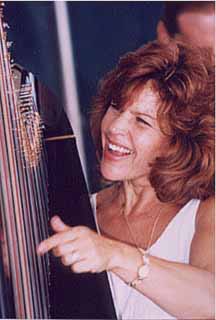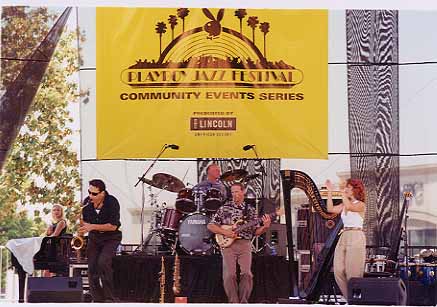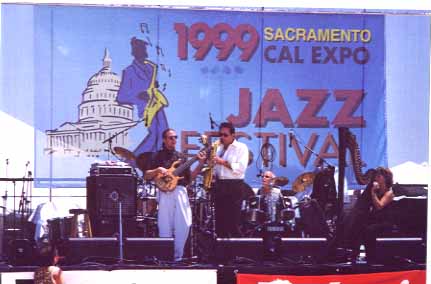














|
Playing Jazz on an Electric Harp in a Band
by Lori Andrews Jazz is the only music I play, and the single most rewarding thing I do. I play in a quartet of electric harp, bass, sax/flute, and drums. One of the things that drew me to jazz is the spontaneity of the playing: I'm constantly searching for new ways to play the same song, and I encourage my band to do the same. My mood, good or bad, allows me to be different each time I play. As well, when I'm playing chords for other soloists, I always try to interpret how they are feeling so I can give back the type of energy they need at that moment. I find jazz to be the most creative music in the world. |
 Harp: Lori Andrews |
|
Playing Jazz The key ingredient in jazz for me is rhythm. I believe that no matter how brilliant your improvising skills, no drummer or any other musician will want to play with you if your time and rhythm are not excellent. I listened to funk music in college and was always drawn to that pulse on the 2nd and 4th beat of the measure. I found a way to create this technique with my left hand which I call my "slap bass" technique, so that even when I'm playing solo, my foot and my listeners' are tapping. "It don't mean a thing"...well, you get it! When you play jazz with a group, you usually follow a pattern: first the melody is stated by the group, and then each musician takes a turn improvising the melody while the others play the harmonies as indicated by the composer. There are many ways of approaching a solo, and the chords used when accompanying, or "comping", can also be altered. This is what makes jazz so creative, and how it happens that when new players sit in with you, you get a fresh outlook on any tune. As a bonus, your circle of musicians grows so you can keep your music vital. When I first got a call to play at the Warehouse in Los Angeles, where I'm now in my ninth year, the sax player asked if his friend Bart, a bass player, could sit in with us. As we played, I could hear that Bart was doing something very scary and unrecognizable to me: he was playing bass notes outside the chord (called "substitutions") to make the chords that I was playing sound really different from what I was expecting. It made me very hesitant in my playing because I was not sure if I should alter my notes to make what he was doing sound good to my ears. I was quite shy and very scared about trying different things on the harp and as a result, I thought the evening was a nightmare because I was second-guessing myself constantly. Well, the owner liked the band so much, he hired us on the spot for two nights a week!  The Lori Andrews JazHarp Quartet, 2000, Playboy Jazz Festival Now I was left with a decision: should I hire the bass player for a whopping $25.00 a night, or not? Well, I know now that I made the politically incorrect choice, but I did call someone else to play the gig. Now and then, though, Bart would come in to sub once in a while and about two years into the gig, I was really starting to hear the uniqueness of his playing in a jazz sense. Eventually I got to trying new and creative things, because Bart had me listening and opening my ears to different jazz chords and feeling pretty confident, at that. Here is an example of some of the chord changes I have learned. Play a simple C7 chord (left hand C/; right hand, bottom up C-E-G-Bb), then an F Major 7 chord (left hand F/; right hand F-A-C-E). Play them a few times to get the sound of them in your head. Now play the C7 chord with an F# in the left hand instead of a C and then the F Major 7 chord. Did you hear how drastically that chord has changed? One note did all that!! Here's a simple example in a very common "turn-around" (a series of chords at the end of a musical phrase to bring you back to the beginning, used for repeating a segment of music): C Major 7 (bass C/; right hand, C-E-G-B) Repeat these chord changes until you're comfortable with them and can do them with fluidity. Then try changing one bass note the second time around: in the C Major 7, play E instead of C in the bass. This gives a very different sound to your turn-around, doesn't it? Sometimes the simplest changes result in the most effective listening experiences. If you want to use more substitutions, try another bass note with the G7 chord the second time around - play a C# in the bass. Now that's jazz!!!! By the way, whatever happened to the bass player who taught me all this? I married him!! But until then, the gig belonged to someone else and I always looked forward to the learning experience I got from playing with Bart, who pushed my musical limits constantly. 
The Lori Andrews JazHarp Quartet, 1999, Sacramento Jazz Festival Equipment I bought a "Salvi electronic" harp many years ago, and I believe it gives me a better sound at a higher volume compared to an amplified acoustic harp, which many other players use. Also, I especially like my harp's contemporary appearance. Unfortunately, sound engineers are not always skilled at getting the best sound for the electric harp, so I have had to be prepared to trouble-shoot by knowing my equipment and the rules to make electronics work. If you feel unable to do this, you might hire someone, like audio engineering students at your local college, to help. Here are a few simple rules you should follow when dealing with amplifiers and such:
Also, I carry spares of everything and I have top-of-the-line gear:
I always "cover my own chair" on every gig, meaning that whatever the job could quite possibly require, I consider it my responsibility to have the necessities with me, such as
   Bass: Bart Samolis Sax: George Shelby Drums: M.B. Gordy The Band When picking instruments to play with the jazz harp, the bass is my first choice. It frees me to be able to "comp" - play chords in the middle section of the harp - with the left hand and solo with the right hand. The only time I wouldn't play that is when the bass player is soloing. At that time I give him a bass line which I feel strengthens his solo, (or maybe no bass line at all, if it seems more appropriate!). The next instrument I like to add is the sax. Because of the different timbre, it enhances the sound of the band. Besides, everyone loves the sax! When he's there he often is the first to play the melody, and then we take turns for our solos. Our saxophonist plays EWI (Electric Wind Instrument) which is wireless, enabling him to move around freely. At some of the festivals where we perform he actually leaves the stage and plays while walking though the crowd. The audience loves this close contact. He is one of the best sax players I have ever heard, plus he's a charmer. To round out the quartet, I feel the drummer is the icing on the cake. I have been using the same drummer for 14 years. It took us a while to lock into the right volume, lightness and dynamics but now we've got it! There are a couple of instruments I would hesitate to use in the band. Although I love both the guitar and the piano, I feel they interfere with the audience's ability to hear the harp. I choose to have the listener know that if it isn't sax or bass--it's the harp! Stage Set-up Finding the best location for the harp on stage can be a problem when you're playing with a band. When we started out, and depending on where I was placed, I saw either the audience or the band, but I really needed to see both. Since we're not playing written music, eye contact is essential in the band to pass signals back and forth. Unlike most other instruments the harp is stationary, so sometimes I have to look through the strings (as though I'm in jail), and I can't ever turn around while playing to see behind me. My solution has been to place myself at an angle in front of the drummer who is rear center stage. This way, I have contact with the full audience, the sax player and the drummer. Unfortunately the bass player is behind me and eye contact is limited, but the more we play together, the less it is needed (especially because he's my husband!). This stage arrangement seems to be "as good as it gets". I love playing with my band! I treasure the moment the music hits the air. I can't take it back and no one else's music compares to it at that very moment. After the gig is over I make myself available to the audience, who love telling me how unique it was and how the music affected them. Never underestimate the power of the harp - especially with a band! |
|
https://open.spotify.com/track/4uTNxwcCRrdQrbYn1kVNpv
(You will need a Spotify account to hear this. Free accounts are available)
[To author biography] [Back to top of page]
Historical Harp | Folk and World Harp | Pedal Harp |
Harp Building | Harp Works | Non-Harps |
Camps & Concerts | Links | Glossary |
Donate! | Get Involved! | Contact Us | About Harp Spectrum
Copyright 2002 - 2017, Harp Spectrum All Rights Reserved